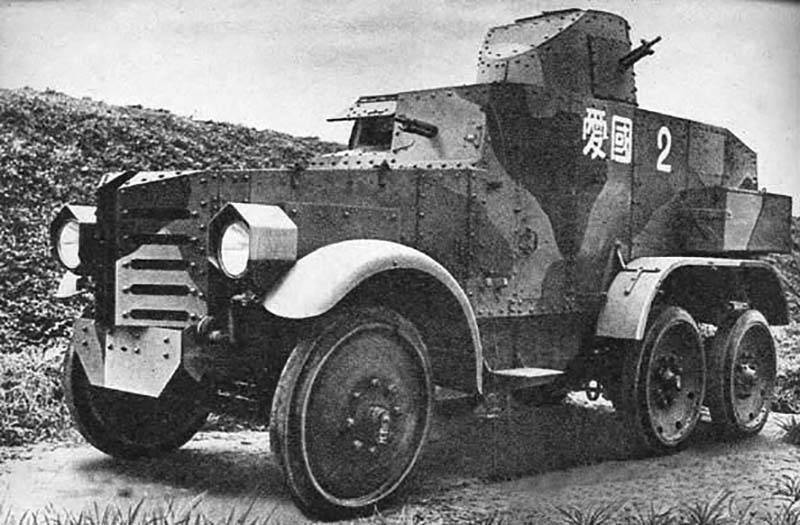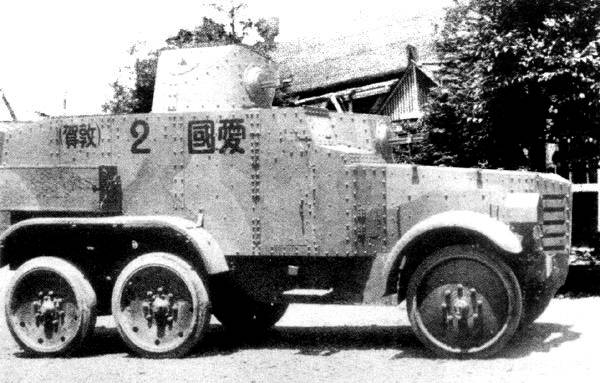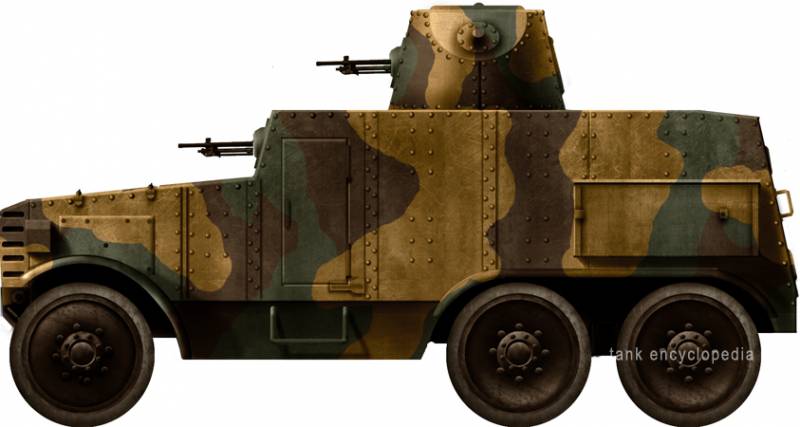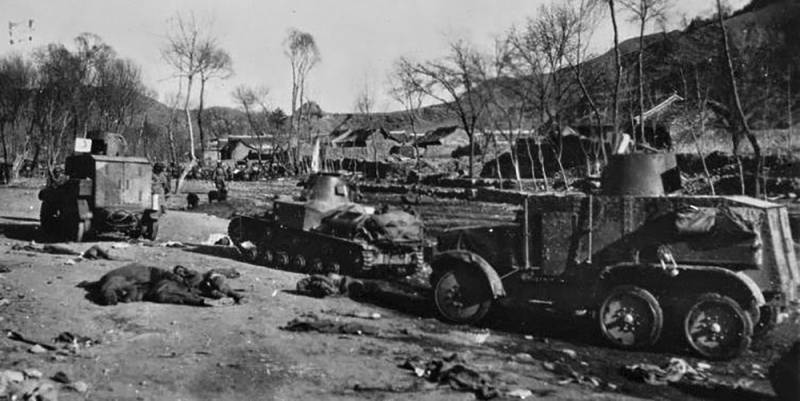Armored car "Type 92" / "Chiyoda" (Japan)
The early armored cars of the Japanese army were built on commercial chassis, which to a certain extent reduced their real characteristics and did not allow to get all the desired results. For this reason, by the beginning of the thirties, the command issued a new technical task, specifying all the existing requirements. Perspective armored car and all its main components should be produced in Japan. At the same time, the car had to be distinguished by high mobility in all landscapes, have good protection and relatively powerful weapons.
In the 1929-30 years, several car manufacturing companies joined the program to create a promising armored car. One of the participants of the work was the firm “Tiyoda”, which was part of the company “Tokyo Gusu Denki KK” (now, after numerous transformations, this organization is called Hino Motors). The plant produced a number of samples of automotive vehicles, including a three-axle truck "Type Q". This platform was supposed to be used in a promising armored car project for the army.
Looking ahead, it should be noted that the armored car from the firm “Tiyoda” successfully coped with the tests and was recommended for use. The order to start operating such a vehicle appeared in the 1932 year, and, in accordance with the Japanese calendar, the armored car received the official designation “Type 92” / “Type 2592”. In addition, it was often referred to by the name of the firm-developer “Chiyoda” (there is also the incorrect spelling of “Chiyoda” associated with the incorrect use of different transcription systems).
Having at its disposal a good chassis, the engineers of the company-developer decided to use the already well-known and proven approach. The cargo chassis should be equipped with an original armored body that meets the requirements. The hull was supposed to protect the internal units and the crew from rifle weapons and splinters, as well as equipped with machine gun weapons. The simplicity of this approach made it possible to greatly simplify and speed up the development of an armored car.
The chassis of the car "Type Q" was traditional for its time frame design with a front engine position, which was placed under the hood. According to known data, such a truck was equipped with a carburetor engine of the British company Wolseley (imported or licensed assembly) hp 75. With the help of a manual manual transmission, torque was delivered to the driving rear axles. It was assumed that such a power plant will provide acceptable performance and, at a minimum, will give certain advantages over existing armored cars.
Chassis serial car was slightly modified. It is based on three bridges with suspension on leaf springs. The front wheels were driven; the rear axles were connected to the transmission. Finalization of the chassis was to replace the wheels. Instead of knitting needles, it was now proposed to use large metal discs. Rear wheel rims have a perforation to reduce weight. Instead of pneumatic tires used solid rubber products. The base chassis also had to keep the regular wings above the wheels.
The body of the armored "Type 92" did not differ engineering or technological complexity. It was proposed to install a metal frame on the chassis, to which armor plates 6 mm thick were fastened on rivets. Booking details had different shapes and sizes, but did not differ in thickness. As a result, protection from all angles was the same.

General view of the armored car
The project provided for the use of anti-bullet protection of both internal compartments and chassis elements. All open areas of the frame were additionally covered with armor shields. In place of the bumper there was a wedge-shaped detail, between the wings of the wheels - wide rectangular plates. Similarly, covered the back of the frame.
A relatively powerful and large engine needed adequate protection. The hood of the Tiyoda armored car differed in its length, although it had a simple form. The front of the engine was covered with a wedge-shaped unit with horizontal slots for air supply to the radiator. Outside the combat situation, half of such a forehead could be diluted to the sides, improving cooling. Trapezoidal sides of the engine compartment dispersed to the sides. The roof was mounted inclined forward. In front of the sides, directly in front of the wings of the wheels, were placed headlights in armor covers. To access the engine, the roof of the hood had hatches with hinged covers.
The back of the hood in its width corresponded to the habitable compartment. Above the roof of the engine compartment was set low frontal sheet with the necessary hatches. The board of the main part of the hull consisted of several rectangular parts, and in its rear part there was a small cut-out for the wheel arch. Stern leaf mounted with a slight slope. The main part of the roof, located above the control post and the fighting compartment, was placed horizontally. It was connected to the stern sheet with a small inclined part.
The project "Type 92" proposed the use of the tower of a relatively complex shape. Part of the forehead, sides and stern of the tower formed a common conical detail. A sloping frontal sheet was attached to the front, mating with the roof. The latter had a slight tilt back. An interesting feature of this tower was the placement of weapons: it received two ball mounts at once. The first was located in the inclined front sheet, the second - in the left side surface.
From its predecessors, the new armored car differed advanced weapons. He was supposed to carry two or three 91 Type machine guns in 6,5 caliber mm. Such a machine gun was a modification of the product "Type 11", adapted for use on armored vehicles. This weapon worked with standard Japanese rifle cartridge 6,5x50 mm "Arisaka" and showed firing rate up to 400-450 shots per minute. Used shop so-called. bunker type with a capacity of 30 cartridges. On the racks of the fighting compartment was placed ammunition in several thousand rounds.
One or two machine guns were supposed to be placed in the turret. One installation of a ball type was placed on an inclined front sheet, the second - on the left side of the tower. It is known that the crews did not always mount both turret machine guns in their places. Apparently, one of them remained styled for ergonomic reasons. It is easy to see that the barrel of two machine guns, which were in the inner space of not the largest tower, could seriously hinder the work of the shooter. Tower machine guns were able to fire in any direction with different angles of vertical guidance. For obvious reasons, the simultaneous use of both machine guns was excluded.

Starboard
The third machine gun was located in the front hull sheet, next to the driver’s workplace. It was intended for firing into the forward hemisphere within a limited sector. In fact, he was an addition to the "main" turret machine guns.
The crew of the armored car "Chiyoda" / "Type 2592" consisted of three people. In front of the habitable compartment housed the driver and shooter. The control post with the workplace of the driver was located at the starboard side. To his left was the shooter. The driver had to follow the road with a rectangular frontal hatch. In a combat situation, the hatch was closed with a lid with a viewing slot. Arrow in any conditions it was proposed to use only regular inspection slots of the machine-gun installation. The second shooter was in the fighting compartment in the tower. In its place there were several inspection devices and slots.
Access to the habitable compartment was provided by a whole set of doors. In front of the sides, at the level of the conditional branch of management, there were two large doors that opened back. For the convenience of the crew, under them were staples. The third door, which had two wings, was installed in the opening of the stern leaf and was actually intended for the shooter.
Dimensions and weight of a promising armored car were limited by the characteristics and capabilities of the chassis. At the same time, according to similar parameters, it hardly differed from the other technology of its time. The length of the “Type 92” was 5 m, width - 1,9 m, height on the roof of the tower - 2,6 m. The combat weight reached 5,6 t. The relatively high specific weight allowed the car to reach speeds up to 60 km / h on a good road. Going out into rugged terrain, the armored car lost mobility, but still retained acceptable characteristics. Also, the machine could not show high permeability, climb steep slopes and overcome water obstacles on deep fords.
A prototype of the new armored vehicle from the Tiyoda company was built in 1931, and soon passed the necessary tests. This project took into account the experience of designing and operating such machines, which made it possible to obtain acceptable characteristics and capabilities. As a result, according to the test results, an armored car was put into service. An official document on this was signed in 1932 year, with the result that the armored car received the army designation "Type 92". It is noteworthy that he was the first adopted armored car, fully developed in Japan.
Then the company-developer received an order for mass batch production of the latest technology. The release of technology continued for several years and was completed, according to various estimates, by the mid-thirties. During this time, the plant "Tiyoda" built about two hundred armored cars. This technique was intended for the imperial army. Deliveries of cars to other units of the armed forces of Japan were not provided.
In the fall of 1931, the Japanese intervention in Manchuria began. To solve the set military-political tasks, the Kwantung Army of Japan needed modern models of weapons and equipment. Even before the outbreak of hostilities, they began to transfer various material units, including new armored cars. In 1932, the newest 92 Type armored cars set out on the continent. According to reports, for the first time they took part in battles during the First Shanghai Battle at the start of the 1932 of the year. Subsequently, this technique, the number of which is constantly growing, regularly became a participant in the fighting.
Depending on the current situation and the tasks assigned, the crews of the Chiyoda armored cars carried out fire support for infantry with the help of machine guns or participated in patrols and escort operations. In the first years of service, such vehicles were mainly involved in solving combat missions. In the future, as new and more sophisticated models arrived, armored vehicles of the “Type 92” began to be transferred to second roles; now they were considered as a vehicle for police operations, convoy escorts, etc.
Despite a gradual change of role, the 2592 Type / Tiyoda armored vehicles continued to work until the second half of the 1930s. Only in 1937-m they were gradually written off. By this time, the equipment had time to develop its resource and could no longer remain in service. During this period, the army began to receive the newest track-type winches “Type 97”, also known as “Te-Ke”. The latter could solve the same tasks as the "Type 92", while having certain advantages over the armored cars. As a result, the process of gradual replacement of obsolete armored combat vehicles started.
Apparently, the replacement program was delayed for several years, but there is no detailed information about this. There is an assumption that a number of Tiyoda armored cars remained in service until Japan entered the Second World War, and such equipment had to take part in battles again. However, there is no documentary evidence of this version. Reliable references to the 92 Type machines in the context of the new war have not yet been found.
Not later than the beginning of the forties, all existing "Type 92" could be written off, and most of them had to go for disassembly. Perhaps some of the machines of this model still managed to take part in the Second World War in the Pacific theater of military operations, but their future was already predetermined. As far as is known, over time, all the existing Chiyoda armored vehicles were destroyed in battle or decommissioned and dismantled. No such car has survived.
History The Japanese program for the construction of armored cars began with engineering projects built on the basis of foreign chassis. Having received the necessary experience, the designers were able to abandon the finished imported equipment, reducing the use of foreign products to a minimum. As a result, the Chiyoda / Type 92 armored car appeared, which actually gave a start to the new direction.
On the materials of the sites:
http://tanks-encyclopedia.com/
http://voenteh.com/
http://zonwar.ru/
https://ikazuchisen.wordpress.com/


Information